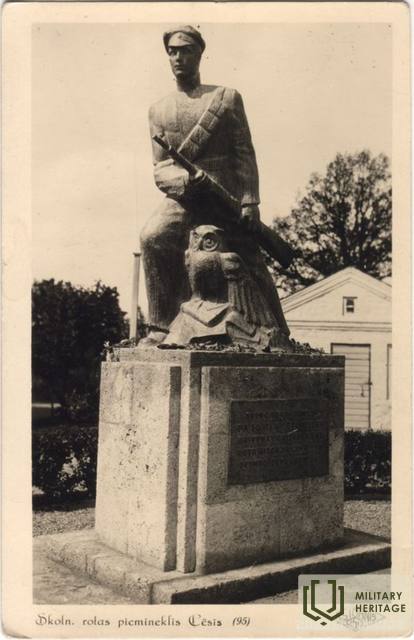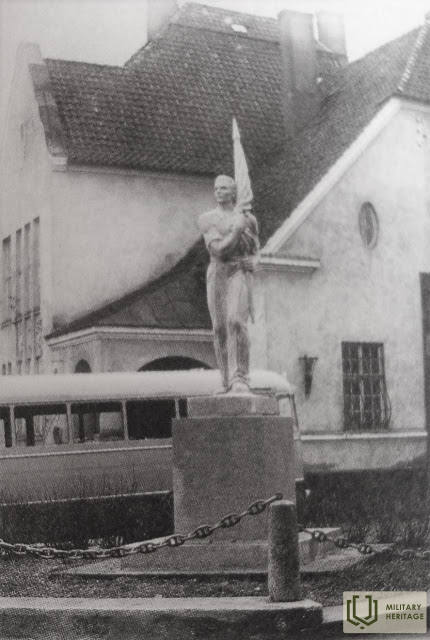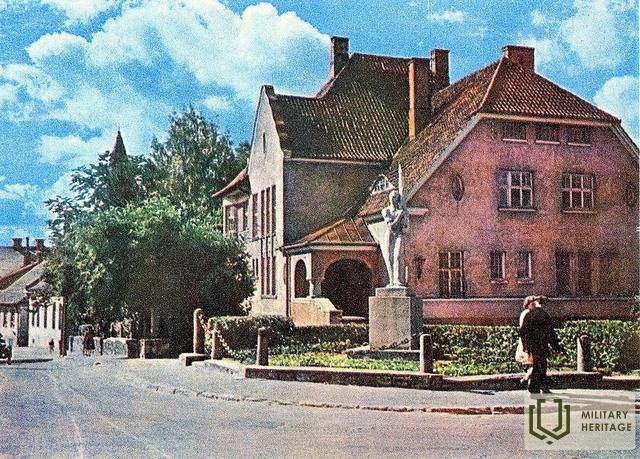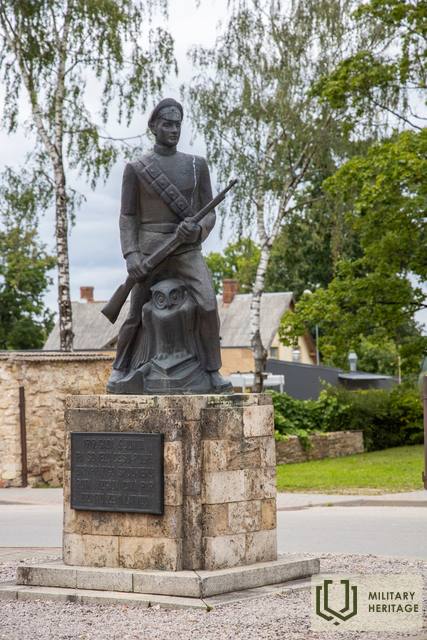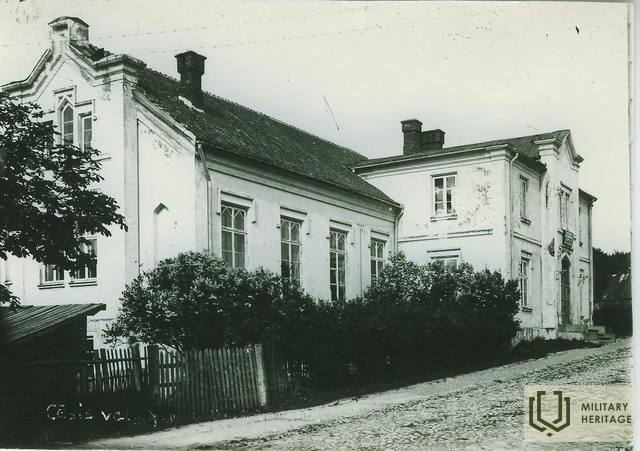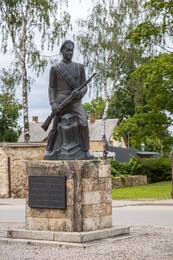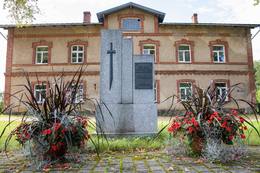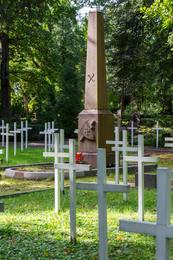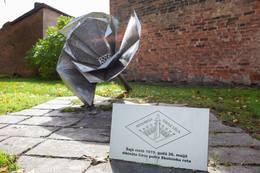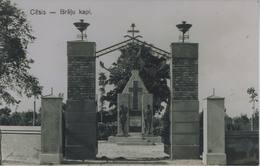The unusual story of the Cēsis Regiment Students' Jewelry Monument
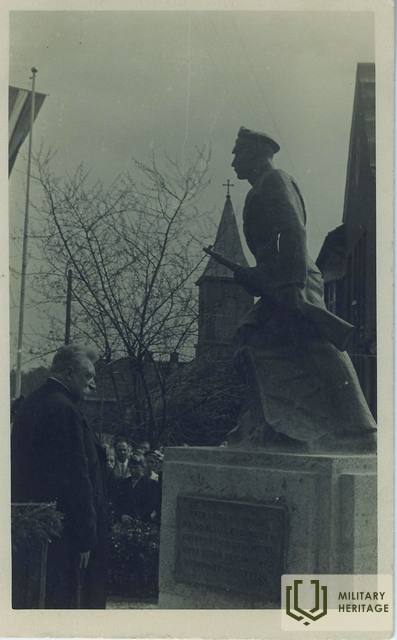
In the Cēsis battles of 1919, a group of volunteers from the Cēsis Regiment took part in the battles of the Cēsis Regiment. Already on the night of June 5 to 6, an hour after midnight, there was anxiety and the ornament was ordered to go into positions. Rota went on the line Mācītājsmuiža - Meijermuiža, which was considered to be the most important battlefield.
Dr. med. Wilhelm Lenz's house. In the early 1930s, this building was purchased by the Cēsis Craftsmen's Association, but after World War II, the building housed the editorial office and printing house of the newspaper "Padomju Druva" (since March 1990, the newspaper "Druva"). On their way to the battlefield, the soldiers of the Pupils' Company, who had come along Palasta Street from their formation in the German Progymnasium, received grenades at the regiment's headquarters. In the vicinity of the headquarters, soldiers of the company on Heermeistera (Gauja) Street had also received a small military briefing. The command post of the commander of the 2nd Cēsis Infantry Regiment was located right across the street - Heermeistera Street No.11 (now Gaujas Street No.11)
One participant of the events described the experience of the Battle of Cēsis on the 10th anniversary of the newspaper "In the Last Moment" (JA "10 years ago, a former company of Cēsis regiments against the Landesver."; 06.06.1929) as follows: "On June 6, at around 1 was anxiety. Everyone quickly got dressed and the student company in 2 wires stood on Dārza Street, divided into special units, distributed battle cartridges. At the intersection of Rīgas Palasta, Vaļņu and Gaujas streets, Senior Lieutenant] [Gustavs] Green showed a short battle maneuver as to surround a certain place. Pie Dr. Lench's houses handed out grenades, and the use was introduced on the spot. From this place, the company went in the direction of Kalnamuiža, Juruģumuiža and Mācītājsmuiža, occupied the middle battlefield of the Cēsis Regiment and protected the line Meijermuiža - Mācītājsmuiža by turning it on. ”
On May 26, 1938, about 100 m from the former Cēsis German Progymnasium, a monument dedicated to the Decoration of Students was unveiled at the intersection of Dārza and Palasta (now Bērzaines and Palasta) streets. On the night of June 5-6, 1919, untrained students of martial arts went from the progymnasium to the first battle. It was symbolized by a bronze-made rifle of a pupil clumsily caught. The owl and books at the student's feet also reminded him that school supplies had been temporarily replaced by weapons. The author of the sketch of the monument was the former soldier of Skolnieki rota, the artist Jānis Rozenbergs (1901-1966), but the idea was realized by the sculptor Rūdolfs Ābol (t) iņš (1909-1944) and the blacksmith Jānis Zibens (1909-1967).
In 1950, the monument was dismantled as undesirable for the Soviet regime.
At the beginning of the Awakening, the first idea to restore the monument was expressed by a group of 1942 graduates of the Cēsis State Gymnasium living in exile during their visit to Latvia in 1989. They also started raising the necessary funds. However, the Cesis City Board made a decision on the restoration of the monument and its installation in its original location only after the restoration of Latvia's independence on September 24, 1992.
Although a formal agreement on the restoration of the monument had just been reached, in reality work on it had already begun. On September 26, the district newspaper "Druva" reported that a limestone had been prepared for the base of the monument, but the sculptor Maija Baltiņa and the architect Imants Timerman had started creating a bronze statue.
However, on September 30, 1992, Ādolfs Cābulis, a resident of Cēsis, submitted an application to the State Inspection for the Protection of Cultural Monuments (VKPAI) and the Brothers' Cemetery Committee (BKK). He claimed that the initiative to restore the monument had now been taken by other people who were acting for selfish purposes and had not received the necessary permission from the authorities. Representatives of this group, including the sculptor Andrejs Jansons, planned to unveil the monument on November 11, 1992, placing it about 15 meters from its original location. Significant visual changes were also planned for the monument, as the soldier designed by J. Rozenberg had grabbed the rifle in the left, thus emphasizing the military unpreparedness of the hastily formed Schoolboy, but the young man formed by M. Baltiņa kept it on the right side. The material also differed - originally the monument was made of copper, but now it was cast in bronze. The former bronze plate was replaced by a copper plate.
In order to carry out additional historical research, the Cēsis City Board decided on October 4, 1992 to stop the restoration of the monument, but the creators of the monument did not take it into account and installed a base with steps in the newly chosen place. The need to place the monument there was explained by the changes introduced in the years of communist occupation in the traffic movement along Bērzaines Street, which can no longer be abandoned. Although the municipality suggested waiting until next year, when it would be possible to try to make a model in nature at the historical location of the monument, the action of the city board was limited by the lack of funds. The bronze statue, which had already been installed and made, had been paid for with funds raised by donations from the Daugava Hawks' Cēsis branch, Latvians in exile and the Latvian People's Front. It was therefore decided, however, to open the restored monument on 11 November 1992, near the historic site. On November 11, 1992, the monument created by the sculptor Maija Baltiņa (1941-2016) was unveiled.
At the same time, in 1992, the monument made by the occupation regime, made by the sculptor Kārlis Jansons, “The Communist Flagman” was dismantled.
Tālis Pumpuriņš, Cēsis History and Art Museum
https://karavirukapi.blogspot.com/2020/02/cesis-piemineklis-cesu-pulka-skolnieku.html
http://sovietheritage.blogspot.com/2017/04/cesu-rajona-padomju-laika-zudusie.html
Related timeline
Related topics
Related objects
Monument for students of the Cēsis Regiment
The monument to the soldiers of the Cēsis Regiment Students’ Company who died in the Battles of Cēsis is located in the city of Cēsis, near the intersection of Palasta and Bērzaines streets. The construction of the monument was proposed by the Soldiers’ Association of the Cēsis Regiment Students’ Company. The monument was unveiled on 26 May 1938. The monument is based on the idea sketched by artist Jānis Rozenbergs, a former soldier of the company. Placed on a metre-high limestone pedestal, the 1.8-metre copper sculpture of a soldier dressed in a school student’s uniform was created by sculptor Rūdolfs Āboltiņš and coppersmith Jānis Zibens. An owl, a symbol of wisdom and knowledge, lies at the soldier’s feet, squatting on and protecting the books of a student who went to war. The sculpture was demolished during the Soviet re-occupation in 1952. A monument named the Komsomol Flag Bearer by sculptor Kārlis Jansons was erected near its former location in 1957. Placed near its historic site, the restored monument was unveiled on 11 November 1992. At the same time, in 1992, a monument to the Komsomol, which had been erected by the occupation regime, was taken down.
Monument to the students' ornaments at the battlefield
On the side of the Cēsis-Āraiši highway, near the former Livu parish.
A monument dedicated to the ornament of volunteers of the Cēsis Regiment, who took part in the battles of Cēsis in 1919, can be seen.
The monument was unveiled on May 29, 1930 near the former Livu parish.
The project of the monument was developed by the former volunteer of the school ornament K.Dzirkalis, the installation works were performed by A.Sproģis firm in Cēsis.
Bronze details according to the author's drawing were created by M.Pluka, they were cast at V.Minūta's factory in Riga. After World War II, the monument was destroyed.
Restored on June 6, 1989, the authors of the restored monument are sculptors A. Jansons and M. Balttiņa, architect I. Timermanis.
Later, the bronze sword and plate were removed for safety reasons and replaced with wooden parts.
Cemetery of Latvian riflemen killed in the First World War and brothers of soldiers killed in the War of Independence
Located in Valmiera City (Center) Cemetery, Lillijas Street 7.
A granite obelisk can be seen, the details of which are forged by the sculptor Wilhelm Trey.
The monument was unveiled on June 22, 1923. About 150 soldiers are buried in the brothers' cemetery.
Several fighters of the First World War and the War of Independence were buried outside the Brothers' Cemetery, including the first dead of the Cēsis Regiment School Company, LKOK Edgars Krieviņš.
At present, there are 14 sets of graves of different lengths in the brothers' cemetery, on which 139 white wooden crosses have been erected, but there are no more plaques with the names of the fallen on the crosses. One black granite cross has survived.
During the communist occupation, intensive civil burials were made in the cemetery of the brothers. After the restoration of independence in 1994, the plan of burials in the brothers' cemetery was changed, and the cemetery clusters are now established crosswise, only one of which has retained its former orientation.
Memorial sign at the founding site of the Cēsis Regiment School Company
Located at Leona Paegles Street 1, next to the red brick facade.
The author of the memorial is the artist Solveiga Vasiljeva, and the idea is based on a flower bud motif. According to the artist, it symbolizes the newly formed personalities - students who have to make an important, responsible and harsh decision in their still short life.
In the form of a memorial, the outer petals of the flower bud are made of geometric, sharp corners, in contrast to the gentle, rounded inside of the bud. The height of the memorial is up to 1.5 m. The memorial was unveiled on May 26, 2011 in Valmiera, the place where the orchestra of the Cēsis Regiment was formed in 1919.
The contours of Latvia are made of artificial cobblestones, on which a plate with the flag and text of the Cēsis Regiment Students' Association is placed:
"At this place on May 26, 1919
Cēsis Regiment Student Company was founded "
Cesis Brothers Cemetery
Located in Cēsis Lejas Cemetery, Lenču Street 15, Cēsis.
One of the most important memorial sites of the First World War and the War of Independence in Cēsis is the Brothers' Cemetery in the Lower Cemetery.
The cemetery is the monument of the Brethren's Cemetery, built in 1927 by the artist and thinker of Cēsis Augustus Julla (1872-1958), dedicated to the soldiers buried in the Brothers' Cemetery from 1915 to 1920.
About 200 soldiers are buried in the Brothers Cemetery of Cēsis Lower Cemetery. Among them, an unknown number of Latvian riflemen and Russian soldiers killed in the First World War, as well as soldiers of German (10), Polish and other nationalities. During the Latvian Liberation War, 22 fallen soldiers of the 5th (2nd) Cēsis Infantry Regiment, as well as 11 freedom fighters who fell in other Latvian army units, were buried in these cemeteries. 2 Estonians, 15 victims of Bolsheviks and also Latvian Red Riflemen are buried in the Brothers' Cemetery.




